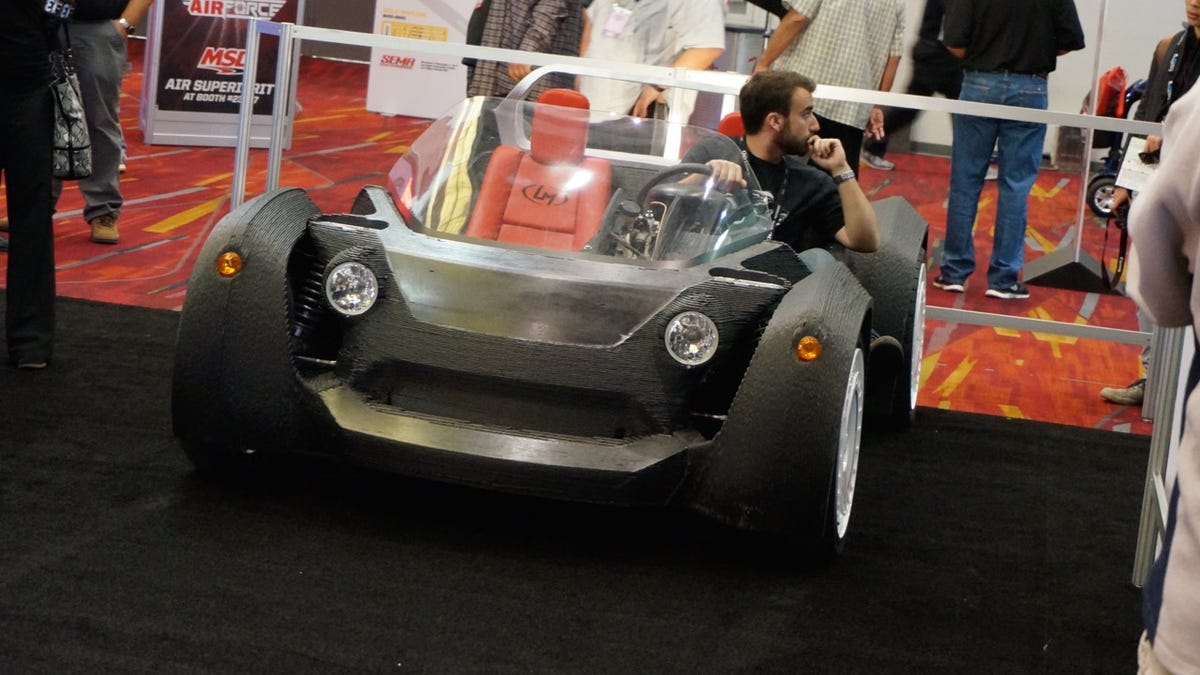Print my ride! Local Motors builds the world's first 3D-printed electric car
The Local Motors Strati EV isn't just the world's first 3D-printed car, it'll also be the first car that you can download and print yourself.

The Local Motors Strati started with an idea. The crew at Local Motors wanted to build the world's first 3D-printed car. Specs were scratched together, project guidelines set and, true to its open-sourced roots, the automaker opened the project up to a crowdsourcing process similar to the one that resulted in the open-sourced, build-it-yourself Rally Fighter.
I met with Local Motors on the floor at the 2014 SEMA Show in Las Vegas and asked about the significance of its 3D-printed car being "open-sourced." I mean, it's not like you can just download a car, right? It turns out that you can.
Local Motors tells me that the vehicle is presented under a Creative Commons license and that all of the information regarding the development, the digital 3D printer files, build manuals and more will be available on Local Motors' website. You will be able to pop online, grab the info and then print your own Strati at home...that is, if you can get access to a big-enough 3D printer. (And if you can't, they have 1:10 scale files for 3D-printing a miniature Strati model for your desk.) People can also contribute to the project adding improvements, tweaks, and mods to the crowdsourced knowledge base. The only stipulation of the general public license is that you can't then sell the community's hard work for profit.
A contest was held to find the best design for their 3D-printed car, which was voted on by their fans. Italian automotive designer Michele Anoè (aka Harlock) penned the winning design, a roadster which met Local Motors' requirements for the sort of angles and shapes that could be created by a 3D printer, incorporation of the raw, stepped look that resulted from 3D printing at that scale, and also looking cool.
With the design in place, Local Motors set about building, er, printing the Strati with partners Cincinnati Incorporated, which provided a 3D printer big enough to spit out a car.
The Strati is printed by stacking down layer upon layer of a combination of about 80 percent ABS plastic and 20 percent carbon fiber reinforcement. The three-axis printer melts these materials into the shape dictated by its computer controller slice by slice. It takes about 212 layers of this material to complete the Strati's chassis.
It may look like a lightweight in the photos, but the carbon-reinforced ABS plastic is stronger and denser than it appears. I rapped my knuckles against one of the fenders expecting something akin to Styrofoam and learned that the 3D-printed material is as tough as metal. It even sounded sort of like metal as I bruised my knuckle against it.
Printing the chassis, fenders and other body parts takes about 44 hours. Local Motors printed the example on display live at the International Manufacturing Technology Show 2014 (ITMS) in Chicago in September. After printing, certain parts of the chassis are then placed onto a computer-controlled Thermwood five-axis router where sections are selectively milled for a smooth look. Other parts, such as the fenders, are left with the raw, stepped look. Finally, the fenders, chassis, and other bits are assembled and it's time to make the Strati go.
A Renault Twizy donates its power train, suspension and steering components to the Strati. Along with the seats, lights, wheels and tires, these are the only bits that are not 3D-printed.
The engine is a 100 percent 12-kW electric motor that is powered by a 6.1-kwh battery. From a full 3.5-hour charge, you're looking at a stated 62-mile range that is, surprisingly, identical to that of the Twizy, despite the Strati weighing nearly twice as much according to Local Motors' guess.The top speed is stated at about 50 mph.
The engine sends its 42 pound-feet of torque to the rear wheels via a single-speed transmission and can take advantage of regenerative braking to complement the front and rear disc brakes, which also came off of the Twizy.
I had an opportunity to talk with Local Motors' Nicholas Bauer (aka "Slick Nick") who worked with adapting the Renault's electric power train for the Strati, and learned about some of the unique challenges of building the world's first 3D-printed EV. You see, the Twizy donor car used a common chassis ground for all of its systems that connects the electrics through the vehicle's metal frame -- this is a common practice for most cars made of steel. The Strati, being built completely of ABS plastic, couldn't use its chassis as a common ground, which led to electrical failure. The team solved the problem by busting open the Twizy's wiring harnesses and individually grounding each vehicle component (from the brake lights to the turn signals to the power train) to a 1-gauge copper wire that now runs the length of the chassis and serves as the common electrical ground for the EV.
With the electrics sorted, the Twizy's steering rack is then transplanted and the suspension bolted onto the ABS chassis after being modified and upgraded with aftermarket springs and dampers to accommodate the additional weight of the Strati. The final pieces of the puzzle are custom-made Fifteen52 EVO SC wheels built to Local Motors' dimensions and shod in narrow Bridgestone 140/70R 18 tires.
The Local Motors Strati is still in the prototype phase, so it's not exactly street-legal yet, but the open-sourced automaker is aiming at legality sometime in 2015, when you should be able to purchase Strati kits from Local Motors in a manner similar to its Rally Fighter or download and remix the plans and print your own.
Local Motors is already planning for SEMA 2015, when it will be returning with 12 more Strati examples that it will hand over to tuners, customizers, modders and hackers as part of its upcoming Mod Men contest.

